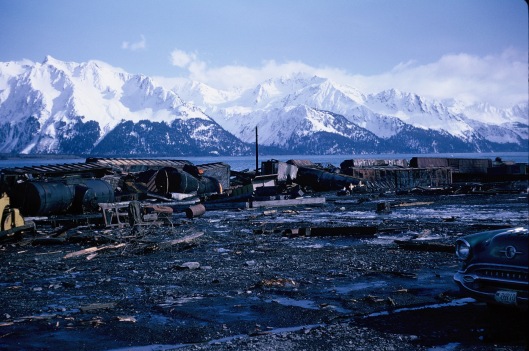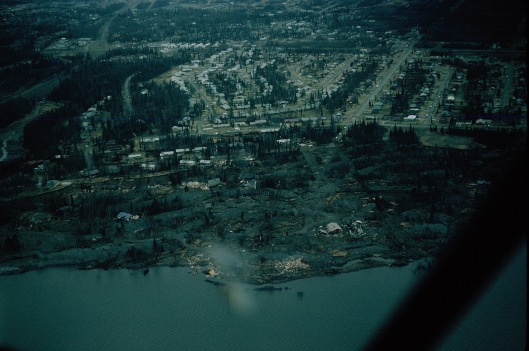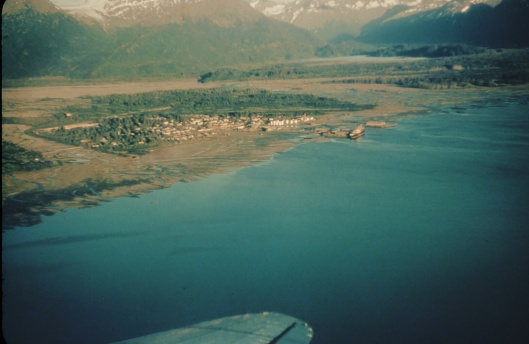At 5:36 p.m. on March 27, 1964, the Good Friday Earthquake changed Alaska’s landscape. Its magnitude, 9.2, made it the second most powerful earthquake ever recorded. I was there.
What history-making event did you live through? Where were you when it happen?
We heard a loud thud and then felt a strong jolt, as though something large had run into the house. My mom, three siblings, and I were sitting at the supper table. Dad was at the clinic delivering a baby. We’d had earthquakes before, but when the shaking and noise increased we were scared.
“Let’s get out of here!” Mom screamed. “The house might crumble!
Ruth and I were barely teenagers; Mark and Mishal were grade-schoolers.
We made our way drunkenly toward the front door. Mishal fell down the steps. Mom pulled her up. The driveway was covered with hard-packed snow. Unable to maintain our balance, we collapsed onto the cold ground, without shoes or coats. Trees swayed as if they were feathers. The ground rumbled and split open, emitting swamp gas from the shallow fields beneath our homestead.
“Oh Jesus, help us!” Mom cried out.
Crouched on all fours and several even prone, we clung together.
After over four hour-long minutes, the noise stopped and the ground stood still. Slowly, we staggered to our feet and returned to the house.
“I feel sick,” said Mom. “Like I’ve been on a boat in rough water.”
The only damage we found was water sloshing out of the suds-saver tub in the laundry room and a fallen flowerpot. None of the china or fragile keepsakes had tumbled out of the shelves, nor had sugar bowls or syrup bottles.
Mom tried to call Dad, but when she picked up the phone all she heard was a woman screaming hysterically. “I’m scared, too,” said Mom. The woman remained out-of-control. Then the phone line went dead
The sun slipped away, edging the pink wisps of clouds with gold against the darkening sky. Darkness closed around us. Aftershocks added to our trepidation.
Mom found candles. None of us went to our separate bedrooms, but crowded together in the basement rumpus room. Remarkably, after several hours, electricity was restored. We turned on the radio – to the shocking news from a Seattle station that no one knew what had had happened to Anchorage, Alaska. The nightmare was not over. The number of people killed would eventually be over 100, with an additional 2,000 homeless.
The Easter church service took on a new meaning. Attendees could identify with the fear and confusion of the guards attending the entrance of Jesus’ tomb. Everyone could certainly understand why.
(adapted from Alaska Bush Pilot Doctor, “The Day the Earth Fell Apart.”)
I will never forget that experience. I will never forget that fear. Several weeks later, a vinyl record was made recording some of the sounds and narrating the events of that Good Friday. When it was played at school, many of my classmates laughed and thought it was funny. I didn’t laugh. Every time they played it, I relived the terror and felt again the earth rumbling and rolling beneath me. Even today I can the black spruce around our driveway bending until the tops touched the ground as the earth moved like a stormy sea.
When I’ve returned to Alaska since that time, I’ve found myself subconsciously “holding my breath” until I leave. Then, I sigh with relief that I made it out of Alaska without being in an earthquake. Certainly there have been tremors that have come with a slam, but nothing like the Big One.
My brother, Mark, has tried to comfort me, “Naomi, if the homestead house made it through the Big One, surely it can make it through any other one again.”
I hope not to every experience a Big One again.
Epicenter of the earthquake:
“Fifty years ago, as the steamship Chena was unloading its cargo in the bustling Valdez harbor, the entire town shuddered, the ground at the waterfront fell away, and waterfront structures collapsed, pulling down the people on them. North America’s most powerful recorded earthquake was underway, its epicenter just 45 miles to the west. Tsunamis finished off much of what was left. Thirty-three people in Valdez died, including children on the collapsed dock who had come to welcome the Chena and its deliveries of fresh fruit and Easter flowers…” (read more)
I have been back to visit Valdez and walked in what is left of the old village. That old village is described in ‘A’ is for Alaska: Teacher to the Territory where Anna Bortel taught for three years.
“There have been instances throughout recent history that generations can point to and say ‘I remember exactly what I was doing at that moment.’.. For some 125,000 Alaskans, it is ar memory they vividly recall on March 27, 1964: the 9.2 Magnitude earthquake that struck Alaska on Good Friday.” Read about the lasting impacts on America’s 49th state and the military and civilian engineering and construction communities, and the people of Alaska…”
Resources
Earthquake Museum in Anchorage, Alaska: http://www.alaskaexperiencetheatre.com
The Day Trees Bent to the Ground: Stories from the ’64 Earthquake, compiled by Janet Boylan.
The Great Alaska Earthquake: Pictorial Histories, by Stan Cohen.
Where were you? Alaska 64 Earthquake, compiled by Joy Griffin. (Mini-stories by Kenai Peninsula residents)





At home in the living room with my Father & brothers reading & watching TV (hey! We were teenagers. We could do that! Suddenly I felt slightly nauseated & started tos says so, but someone else said it first. Someone else said ‘so do I’. then we all realized we were having an earthquake.
This wans’t my first quake but it felt strangely different. I looked out our window & watched the side of the arctic entry undulate slowly in a wave. Dad said ‘this was a big quake somewhere’. he was right. Reports of devastation along the coast.
It’s an ill wind that blows no good. Within 3 weeks Dad lost his job (pastor of a Baptist Church in the Fairbanks area). We quiclkly moved to Anchorage where he became a Corps of Engineers construction inspector on earthquake reclamation projects. disasters have economic & social consequences, both good & bad.
25 years later my radio alarm woke me in my Juneau apartment with frantic news about the Exxon Valdes fiasco. since that time I’ve been actively engaged in preserving permanent State TGovernment records about the Spill. Most recently I led a 2 year project to review, cull and organize the Department of Law’s case file (@ 3500 cubic feet) of Exxon litigation records.